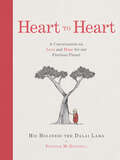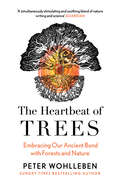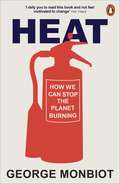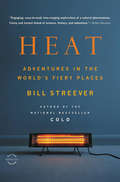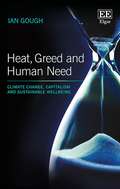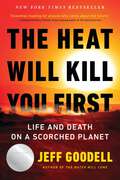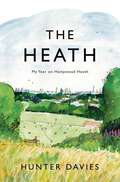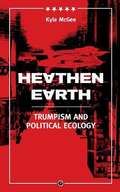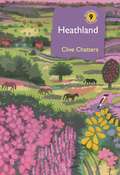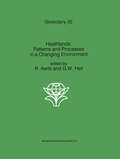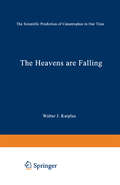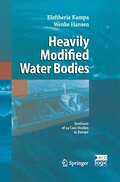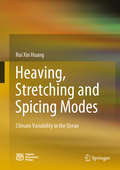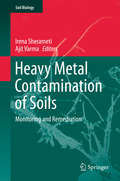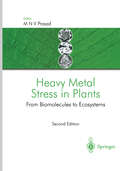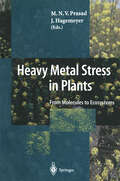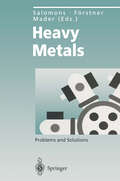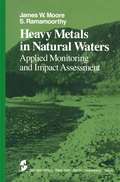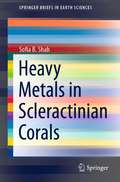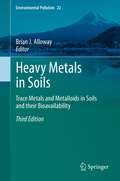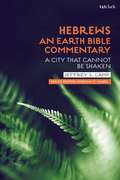- Table View
- List View
Heart to Heart: A Conversation On Love And Hope For Our Precious Planet
by His Holiness Dalai Lama Patrick McDonnellFrom His Holiness the Dalai Lama and Mutt’s cartoonist and award-winning author Patrick McDonnell comes a powerful and timely gem of a book on how to heal our relationship with the planet and each other.
The Heartbeat of Trees
by Peter WohllebenFROM THE AUTHOR OF THE SUNDAY TIMES BESTSELLER, THE HIDDEN LIFE OF TREES ‘A simultaneously stimulating and soothing blend of nature writing and science … Strongly encourages tree hugging for our own, human sake’ Guardian Summer Reads 2021
Heat: How We Can Stop the Planet Burning
by George MonbiotStarted to worry about just how hot our world is going to get, and whether you can do anything about it? As the effect of climate change grows by the day, so does the amount of hot air and bluster spouted by politicians and businessmen on what we should do about it. What with the excuses, the lies, the fudged figures, the PR greenwashing and the downright misinformation on the power of everything from wind turbines to carbon trading, when it comes to saving the world, most people don't know what they're talking about. Luckily, George Monbiot - scourge of big business, riler of governments, arch-enemy of climate change deniers everywhere - does. Packed with killer facts and inspiring ideas, shot through with passion and underlined by brilliant investigative journalism, with a copy of Heat you really can protect the planet. 'I defy you to read this book and not feel motivated to change' The Times
Heat: Adventures in the World's Fiery Places
by Bill StreeverAn adventurous ride through the most blisteringly hot regions of science, history, and culture. Melting glaciers, warming oceans, droughts-it's clear that today's world is getting hotter. But while we know the agony of a sunburn or the comfort of our winter heaters, do we really understand heat? A bestselling scientist and nature writer who goes to any extreme to uncover the answers, Bill Streever sets off to find out what heat really means. Let him be your guide and you'll firewalk across hot coals and sweat it out in Death Valley, experience intense fever and fire, learn about the invention of matches and the chemistry of cooking, drink crude oil, and explore thermonuclear weapons and the hottest moment of all time-the big bang. Written in Streever's signature spare and refreshing prose, Heat is an adventurous personal narrative that leaves readers with a new vision of an everyday experience-how heat works, its history, and its relationship to daily life.
Heat, Greed And Human Need: Climate Change, Capitalism And Sustainable Wellbeing
by Ian GoughThis exceptional book considers how far catastrophic global warming can be averted in an economic system that is greedy for growth, without worsening deprivation and inequality. The satisfaction of human needs - as opposed to wants - is the only viable measure for negotiating trade-offs between climate change, capitalism and human wellbeing, now and in the future. The author critically examines the political economy of capitalism and offers a long-term, interdisciplinary analysis of the prospects for keeping the rise in global temperatures below two degrees, while also improving equity and social justice. A three-stage transition is proposed with useful practical policies. First, `green growth': cut carbon emissions from production across the world. Second, `recompose' patterns of consumption in the rich world, cutting high-energy luxuries in favour of low-energy routes to meeting basic needs. Third, because the first two are perilously insufficient, move towards an economy that flourishes without growth. Heat, Greed and Human Need is vital for researchers and students of the environment, public and social policy, economics, political theory and development studies. For those advocating political, social and environmental reform this book presents excellent practical eco-social policies to achieve both sustainable consumption and social justice.
Heat, Greed and Human Need: Climate Change, Capitalism and Sustainable Wellbeing
by Ian GoughThis exceptional book considers how far catastrophic global warming can be averted in an economic system that is greedy for growth, without worsening deprivation and inequality. The satisfaction of human needs – as opposed to wants – is the only viable measure for negotiating trade-offs between climate change, capitalism and human wellbeing, now and in the future. The author critically examines the political economy of capitalism and offers a long-term, interdisciplinary analysis of the prospects for keeping the rise in global temperatures below two degrees, while also improving equity and social justice. A three-stage transition is proposed with useful practical policies. First, ‘green growth’: cut carbon emissions from production across the world. Second, ‘recompose’ patterns of consumption in the rich world, cutting high-energy luxuries in favour of low-energy routes to meeting basic needs. Third, because the first two are perilously insufficient, move towards an economy that flourishes without growth. Heat, Greed and Human Need is vital for researchers and students of the environment, public and social policy, economics, political theory and development studies. For those advocating political, social and environmental reform this book presents excellent practical eco-social policies to achieve both sustainable consumption and social justice.
The Heat Will Kill You First: Life and Death on a Scorched Planet
by Jeff GoodellMost Anticipated by The New York Times and The Washington Post• New York Times bestselling journalist's "masterful, bracing" (David Wallace-Wells) investigation exposes "through stellar reporting, artful storytelling and fascinating scientific explanations" (Naomi Klein) an explosive new understanding of heat and the impact that rising temperatures will have on our lives and on our planet. "Entertaining and thoroughly researched," (Al Gore), it will completely change the way you see the world, and despite its urgent themes, is injected with "eternal optimism" (Michael Mann) on how to combat one of the most important issues of our time. &“When heat comes, it&’s invisible. It doesn&’t bend tree branches or blow hair across your face to let you know it&’s arrived…. The sun feels like the barrel of a gun pointed at you.&” The world is waking up to a new reality: wildfires are now seasonal in California, the Northeast is getting less and less snow each winter, and the ice sheets in the Arctic and Antarctica are melting fast. Heat is the first order threat that drives all other impacts of the climate crisis. And as the temperature rises, it is revealing fault lines in our governments, our politics, our economy, and our values. The basic science is not complicated: Stop burning fossil fuels tomorrow, and the global temperature will stop rising tomorrow. Stop burning fossil fuels in 50 years, and the temperature will keep rising for 50 years, making parts of our planet virtually uninhabitable. It&’s up to us. The hotter it gets, the deeper and wider our fault lines will open. The Heat Will Kill You First is about the extreme ways in which our planet is already changing. It is about why spring is coming a few weeks earlier and fall is coming a few weeks later and the impact that will have on everything from our food supply to disease outbreaks. It is about what will happen to our lives and our communities when typical summer days in Chicago or Boston go from 90° F to 110°F. A heatwave, Goodell explains, is a predatory event— one that culls out the most vulnerable people. But that is changing. As heatwaves become more intense and more common, they will become more democratic. As an award-winning journalist who has been at the forefront of environmental journalism for decades, Goodell&’s new book may be his most provocative yet, explaining how extreme heat will dramatically change the world as we know it. Masterfully reported, mixing the latest scientific insight with on-the-ground storytelling, Jeff Goodell tackles the big questions and uncovers how extreme heat is a force beyond anything we have reckoned with before.
The Heat Will Kill You First: Life and Death on a Scorched Planet
by Jeff GoodellNew York Times best-selling journalist Jeff Goodell presents a "masterful, bracing" (David Wallace-Wells) examination of the impact that temperature rise will have on our lives and on our planet, offering a vital new perspective on where we are headed, how we can prepare, and what is at stake if we fail to act. &“When heat comes, it&’s invisible. It doesn&’t bend tree branches or blow hair across your face to let you know it&’s arrived…. The sun feels like the barrel of a gun pointed at you.&” The world is waking up to a new reality: wildfires are now seasonal in California, the Northeast is getting less and less snow each winter, and the ice sheets in the Arctic and Antarctica are melting fast. Heat is the first order threat that drives all other impacts of the climate crisis. And as the temperature rises, it is revealing fault lines in our governments, our politics, our economy, and our values. The basic science is not complicated: Stop burning fossil fuels tomorrow, and the global temperature will stop rising tomorrow. Stop burning fossil fuels in 50 years, and the temperature will keep rising for 50 years, making parts of our planet virtually uninhabitable. It&’s up to us. The hotter it gets, the deeper and wider our fault lines will open. The Heat Will Kill You First is about the extreme ways in which our planet is already changing. It is about why spring is coming a few weeks earlier and fall is coming a few weeks later and the impact that will have on everything from our food supply to disease outbreaks. It is about what will happen to our lives and our communities when typical summer days in Chicago or Boston go from 90° F to 110°F. A heatwave, Goodell explains, is a predatory event— one that culls out the most vulnerable people. But that is changing. As heatwaves become more intense and more common, they will become more democratic. As an award-winning journalist who has been at the forefront of environmental journalism for decades, Goodell&’s new book may be his most provocative yet, explaining how extreme heat will dramatically change the world as we know it. Masterfully reported, mixing the latest scientific insight with on-the-ground storytelling, Jeff Goodell tackles the big questions and uncovers how extreme heat is a force beyond anything we have reckoned with before.
The Heath: My Year on Hampstead Heath
by Hunter DaviesAn engaging portrait of Hampstead Heath – a place rich not just in natural wonders but in history and monuments, emotions and memories, people and places. 'I enjoyed every inch of the way, from Parliament Hill to the Pergola... A late-life little masterpiece' Ferdinand Mount 'A love letter, both to the Heath and to his late wife' Islington Tribune 'An affectionate book which blends personal anecdote, history and interviews' Ham & HighThe eight hundred acres of Hampstead Heath lie just four miles from central London; and yet unlike the manicured inner-city parks, it feels like the countryside: it has hills and lakes, wild spots and tame spots.Hunter Davies has lived within a stone's throw of Hampstead Heath for more than sixty years and has walked on it nearly every day of his London life. For him, it is not just a place of recreation and relaxation but also a treasure-house of memories and emotions. In The Heath, he visits all parts of this, the largest area of common land in Britain's capital city: from Kenwood House to the Vale of Health, from Parliament Hill to Boudicca's Mound, and from the Ladies Bathing Pond to the fabulous pergola. As he walks, Davies talks to the diverse array of individuals who frequent the Heath: regulars; visitors; dog walkers; stall holders at the weekly farmer's market; famous faces having their morning stroll; twenty-first-century hippies spreading peace, love and happiness.
Heathen Earth: Trumpism and Political Ecology
by Kyle McGeeHeathen Earth: Trumpism and Political Ecology looks beyond the rising fortunes of authoritarian nationalism in a fossil-fueled late capitalist world to encounter its conditions. Trumpism represents an alternative to the forces undermining the very cosmology of the modern West from two opposing directions. The global economy, the pinnacle of modernization, has brought along a dark side of massive inequality, corrupt institutions, colonial violence, and environmental destruction, while global warming, the nadir of modernity, threatens to undo the foundations of all states and all markets. To the vertigo of placelessness, symptomatic of globalization, is added the ecological vertigo of landlessness. With reality slowly fragmenting, it is only too obvious in this light that Trumpism and other nationalist movements would attract massive hordes of supporters. Promising to expel foreigners and to restore unity and equality by taking power back from the global elites, while utterly denying the climate science that calls ordinary means of subsistence and consumption radically into question, Trumpism can be seen as an antidote to the toxic combination of global markets and global warming. The irony, of course, is that Trumpism only responds to these dangers by doubling down on the reckless expansionist logic that gave rise to them in the first place. This book, composed entirely between November 8, 2016 and January 20, 2017, examines Trumpism according to its regime of political representation (despotism), its political ontology (nativism), and its political ecology (geocide), while laying the groundwork for an alternative politics and a resistant, responsive ecology of the incompossible.
Heathland (British Wildlife Collection)
by Clive ChattersHeathlands are so much more than simply purple carpets of heather. They are ancient landscapes found throughout Britain that support a complex of inter-related species and an immense diversity of habitats. They also possess a unique human history defined by the struggle between pastoralism and the competing demands of those who seek exclusive use of the land.In this latest addition to the British Wildlife Collection, Clive Chatters introduces us to Britain's heathlands and their anatomy. He then takes the reader on a geographical heathland tour – from the maritime subarctic of the Shetlands to the mild wetness of the Atlantic coast – with an in memoriam nod to those heaths that have been erased from common memory and understanding. He concludes with a review of how people have perceived and used heathland wildlife over the ages, and sets out a future vision for this iconic landscape, its unique habitats and the species that live there.Most of our heaths are pale shadows of their former selves. However, Chatters argues, it is not inevitable that the catastrophic losses of the recent past are the destiny of our remaining heaths. Should we wish, their place in the countryside as an integral part of British culture can be secured.
Heathland (British Wildlife Collection)
by Clive ChattersHeathlands are so much more than simply purple carpets of heather. They are ancient landscapes found throughout Britain that support a complex of inter-related species and an immense diversity of habitats. They also possess a unique human history defined by the struggle between pastoralism and the competing demands of those who seek exclusive use of the land. In this latest addition to the British Wildlife Collection, Clive Chatters introduces us to Britain's heathlands and their anatomy. He then takes the reader on a geographical heathland tour – from the maritime sub-arctic of the Shetlands to the mild wetness of the Atlantic coast – with an in memoriam nod to those heaths that have been erased from common memory and understanding. He concludes with a review of how people have perceived and used heathland wildlife over the ages, and sets out a future vision for this iconic landscape, its unique habitats and the species that live there. Most of our heaths are pale shadows of their former selves. However, Chatters argues, it is not inevitable that the catastrophic losses of the recent past are the destiny of our remaining heaths. Should we wish, their place in the countryside as an integral part of British culture can be secured.
Heathlands: Patterns and Processes in a Changing Environment (Geobotany #20)
by R. AertsIncreased atmospheric nitrogen deposition and changes in the management of heathlands have caused a significant change in the species composition of the NW-European heathlands. This change from ericaceous towards gramineous dominance is analysed in detail in Heathlands: Patterns and Processes in a Changing Environment. Special emphasis is put on the effects of increased atmospheric nutrient input on nutrient cycling, competition between plant species and plant--herbivore interactions. The possibilities for the long-term conservation of heathlands are discussed by considering regeneration from seed and the usefulness of mathematical management models. The book provides a synthesis of pure and applied plant ecology. It is vital reading for plant ecologists, biological conservationists, heathland managers and government decision makers.
Heavily Modified Water Bodies: Synthesis of 34 Case Studies in Europe (International and European Environmental Policy Series)
by Eleftheria Kampa Wenke HansenThis book presents the results of thirty-four case studies in an EU-sponsored project on heavily modified water bodies. The account emphasizes the methods used in the process of identification and designation, and identifies further research needs. The contents are the basis for the agreed European Guidance on artificial and heavily modified water bodies to be used by practitioners in the implementation of the Water Framework Directive.
Heaving, Stretching and Spicing Modes: Climate Variability in the Ocean (Springer Oceanography Ser.)
by Rui Xin HuangThis book is focused on fundamental aspects of climate variability in the ocean, in particular changes of the wind-driven circulation. The vertical movement of isopycnal (isothermal) layers, including their stretching and compression, is called heaving and stretching. A major part of climate variability in the ocean is heaving in nature. Heave is primarily associated with the adiabatic motions of isopycnal layers due to change of wind stress. It is rather difficult to separate the contributions from adiabatic and diabatic processes.Isopycnal analysis has been widely used in climate study; however, it is much more accurate to study the isopycnal layers. Here climate signals are examined in terms of changes of layer depth, layer thickness, layer temperature/salinity, spicity and others.In addition to the traditional Theta-S diagram, the sigma-pi (potential density – potential spicity) diagram can also be used in analyzing water mass property distribution and climate variability. In fact, a radius of signal can be defined rigorously for signals in the sigma-pi diagram; the combination of isopycnal analysis and evaluation of radius of signal provides a powerful tool in analyzing climate variability in the world oceans.
Heavy Metal Contamination of Soils: Monitoring and Remediation (Soil Biology #44)
by Irena Sherameti Ajit VarmaFollowing a description of the various sources and factors influencing the contents of heavy metal pollution in post-catastrophic and agricultural soils, subsequent chapters examine soil enzymes and eggs as bio-monitors, lead adsorption, the effects of arsenic on microbial diversity, and the effects of Mediterranean grasslands on abandoned mines. A third section focuses on the adaptation strategies used by plants and bacteria, such as Pinus sylvestris in industrial areas, and the rhizosphere in contaminated tropical soils and soil treated with sewage sludge. Further topics addressed include strategies of bioremediation, e.g. using transgenic plants as tools for soil remediation.This new volume on heavy metals in soil will be of interest to researchers and scholars in microbial and plant biotechnology, agriculture, the environmental sciences and soil ecology.
Heavy Metal Stress in Plants: From Biomolecules to Ecosystems
by M. N. V. PrasadWhilst heavy metal phytotoxicity has been known for more than a century, it is astonishing that interest in the effects of heavy metals on organisms has only recently received added attention. Research in the past years, however, has confirmed the immense damage by metal pollution to plants, the soil and ultimately to humans. This completely updated and enlarged second edition gives a state-of-the art review on both field and laboratory work. It deals with the various functional and ecological aspects of heavy metal stress on plants and outlines the scope for future research and the possibilities for remediation.
Heavy Metal Stress in Plants: From Molecules to Ecosystems
by M. N. V. Prasad Jürgen HagemeyerHeavy metal phytotoxicity has been known for more than a century. However, research in the past years has confirmed the immense damage by metal pollution to plants, the soil and ultimately to humans. By reviewing both field and laboratory work, this book deals with the various functional and ecological aspects of heavy metal stress on plants and outlines the scope for future research and the possibilities for remediation.
Heavy Metals: Problems and Solutions (Environmental Science and Engineering)
by Wim Salomons Ulrich Förstner Pavel Mader"Heavy Metals: Problems and Solutions" is divided into three sections dealing with basic geochemical processes, remediation and case studies. The basic geochemical processes are discussed with respect to mobility in the environment and impact as well as methods to derive guidelines for heavy metals. Remediation focuses on currently available methods to treat contaminated sediments and soils. In addition, it considers the concept of geochemical engineering for remediation of large areas contaminated by metals. A number of case studies of polluted sediments and soils and their environmental impact highlight the principles discussed in the first two sections.
Heavy Metals in Natural Waters: Applied Monitoring and Impact Assessment (Springer Series on Environmental Management)
by J.W. Moore S. RamamoorthyThis series is dedicated to serving the growing community of scholars and practitioners concerned with the principles and applications of environ mental management. Each volume is a thorough treatment of a specific topic of importance for proper management practices. A fundamental objective of these books is to help the reader discern and implement man's stewardship of our environment and the world's renewable re sources. For we must strive to understand the relationship between man and nature, act to bring harmony to it, and nurture an environment that is both stable and productive. These objectives have often eluded us because the pursuit of other individual and societal goals has diverted us from a course of living in balance with the environment. At times, therefore, the environmental manager may have to exert restrictive control, which is usually best applied to man, not nature. Attempts to alter or harness nature have often failed or backfired, as exemplified by the results of imprudent use of herbicides, fertilizers, water, and other agents. Each book in this series will shed light on the fundamental and applied aspects of environmental management. It is hoped that each will help solve a practical and serious environmental problem.
Heavy Metals in Scleractinian Corals (SpringerBriefs in Earth Sciences)
by Sofia B. ShahThis book provides an in-depth review of heavy metals in corals, describing the sources of heavy metals in the marine environment and their effect on corals. It is designed to serve as a unique reference for upcoming marine researchers and chemists, advanced undergraduate and postgraduate students as well as those interested in marine pollution with respect to heavy metals. The book explains the basics as well as the state-of-the-art regarding heavy metals and corals and is engaging and clearly written and narrated, providing readers with the fundamental tools about the subject matter that they need in their specific fields. It allows readers to understand and appreciate the interactions between the atmosphere, ocean, and the geosphere. Detailed reference is included for the benefit of the reader. The specific objectives of this book are (i) to inform/educate the reader about persistent pollutants such as heavy metals, (ii) to identify sources of heavy metals in the marine environment, (iii) to inform about route of exposure and uptake of the heavy metal pollutants by corals, (iv) to elaborate about the effect of heavy metal pollutants on the coral reef ecosystems, (v) to discuss the ways in which heavy metal regulation occurs in corals, (vi) to impact current knowledge regarding heavy metals in the marine environment, and (vii) to briefly show chemical analysis and instrumentation for analyzing heavy metals.
Heavy Metals in Soils: Trace Metals and Metalloids in Soils and their Bioavailability (Environmental Pollution #22)
by Brian J. AllowayThis third edition of the book has been completely re-written, providing a wider scope and enhanced coverage. It covers the general principles of the natural occurrence, pollution sources, chemical analysis, soil chemical behaviour and soil-plant-animal relationships of heavy metals and metalloids, followed by a detailed coverage of 21 individual elements, including: antimony, arsenic, barium, cadmium, chromium, cobalt, copper, gold, lead, manganese, mercury, molybdenum, nickel, selenium, silver, thallium, tin, tungsten, uranium, vanadium and zinc. The book is highly relevant for those involved in environmental science, soil science, geochemistry, agronomy, environmental health, and environmental engineering, including specialists responsible for the management and clean-up of contaminated land.
Hebrews: A City That Cannot Be Shaken (Earth Bible Commentary)
by Jeffrey S. LampIn this new ecological commentary on the letter to the Hebrews, Jeffrey S. Lamp makes use of approaches developed in the relatively new field of Ecological Hermeneutics to shed light upon the connection of Hebrews with Earth.Hebrews is frequently characterized as portraying a dualistic cosmology that diminishes the material world, muting the voice of Earth. Conversely, Lamp argues that though Hebrews cannot be construed as an ecological treatise, the contours of the letter's presentation may be subverted by reading from an ecological perspective, such that cues provided by the author of Hebrews serve as opportunities to hear Earth's voice in the letter. Three movements, corresponding to thematic interests of the author of Hebrews, form the framework of this ecological reading: the Son as the agent of creation, the Son depicted as the Second Adam, and the New Jerusalem as the eschatological dwelling place of God. This ecological reading of Hebrews aims to shape its readers into those who fulfill the soteriological aims of God in and for the world.
Hebrews: A City That Cannot Be Shaken (Earth Bible Commentary)
by Jeffrey S. LampIn this new ecological commentary on the letter to the Hebrews, Jeffrey S. Lamp makes use of approaches developed in the relatively new field of Ecological Hermeneutics to shed light upon the connection of Hebrews with Earth.Hebrews is frequently characterized as portraying a dualistic cosmology that diminishes the material world, muting the voice of Earth. Conversely, Lamp argues that though Hebrews cannot be construed as an ecological treatise, the contours of the letter's presentation may be subverted by reading from an ecological perspective, such that cues provided by the author of Hebrews serve as opportunities to hear Earth's voice in the letter. Three movements, corresponding to thematic interests of the author of Hebrews, form the framework of this ecological reading: the Son as the agent of creation, the Son depicted as the Second Adam, and the New Jerusalem as the eschatological dwelling place of God. This ecological reading of Hebrews aims to shape its readers into those who fulfill the soteriological aims of God in and for the world.
